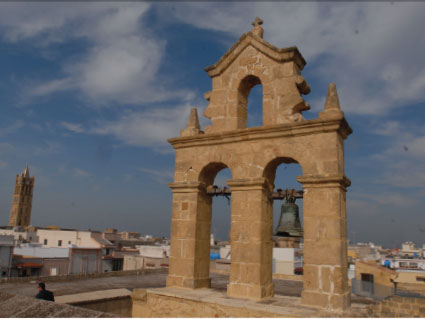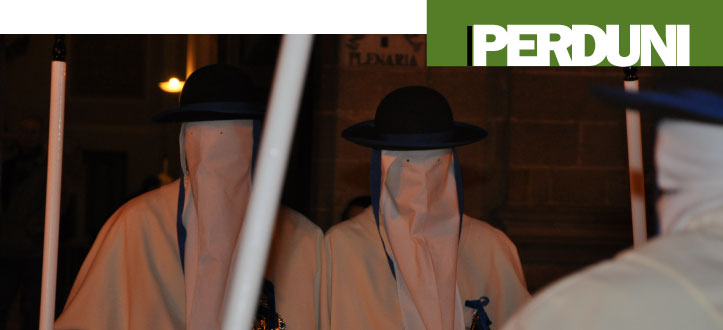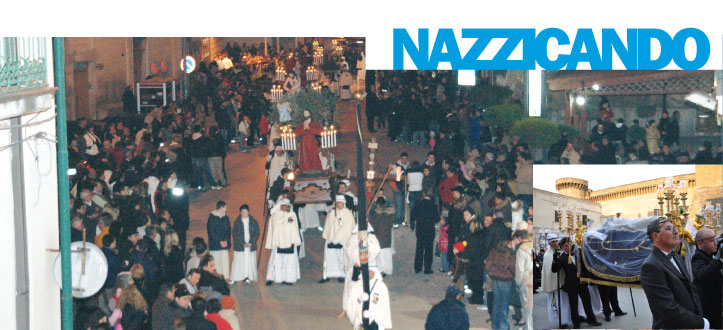





Every year the Confraternity organizes the procession of the so-called “perduni”, couples of barefoot brothers who, walking dangling left-to-right, properly “nazzicando” reach the Mother Church. This is a very ancient rite inherited from the Carmelita Monks who, every year, used to leave the monastery and walked through the Palestinian Mont to visit the place where Jesus Christ had been buried. After the Saracen invasions, around 1235 the Monks came to Europe and were granted the permission to pray Jesus in the churches on Holy Thursday. This religious function attracts many people who want to follow the pilgrims and visit the Sepulchres.

At 3.30 p.m., the main door of the Confraternity’s old seat is opened and the first brother, barefoot with his face covered, goes out while grasping the pilgrim’s stick and the so-called ëtroccolaí, a musical instrument: he crosses the threshold of the Confraternity’s Church and the Holy Friday Procession starts. Here in Pulsano such a rite has been celebrating for three centuries. This is the most beautiful, important, heartfelt and demanding ritual, which attracts to Pulsano a great number of believers. It is composed of three symbols - troccola, gonfalon, and the Mysteries’ Cross - and eight statues representing the Passion of Jesus Christs. The troccola is a six meters long wooden instrument with six metal knockers: when it is not played, the Troccolante (the one who carries the troccola) holds it very tight under his arms so that it cannot produce any sound. The black Gonfalon of the Confraternity represents mourning: it is sail-shaped with a round hand-painted canvass in its centre portraying the Madonna of Carmine and the souls of Purgatory. Soon after the Gonfalon, there is another important symbol of the Procession: the Mysteries’ Cross, on which all the symbols of the passion of Christ are attached. After follows the procession of the statues representing the Mysteries: the statues are extremely expressive, exceptionally beautiful and of priceless artistic value. All the statues have crystal eyes, are made of wood and hand-carved by sculptors belonging to the Neapolitan school. The first statues coming out are Christ praying in the Olive Grove, Christ bound to the column, Ecce Homo and Christ at Calvary were made by the sculptor Giuseppe Greco in 1834/36, while the statue of Dead Christ was made by the In 1799 Giuseppe Pagano, a Neapolitan sculptor, carved out from a single piece of wood. Made by an anonymous artist is the wooden statue of Our Lady of Sorrows, recorded on the registers of the Confraternity’s personal property since the early 18th century. The only statue that is not made of wood is the Crucifix, made of papier mâché and crystal eyes; it is a valuable work of art belonging to the Leccese school. The ritual symbols and the statues are carried across the streets of the town dangling (properly “nazzicando” as they call the left-to-right dangling walking) to the rhythm of the funeral marches played by local musical bands. Two gendarmes in full uniform and four horsemen escort the beautiful and superior statue of Dead Christ. The places of honor, once occupied by the noble families of the town, are now occupied by those believers who distinguish themselves by their works of mercy towards the Confraternity and the Church. The Prior of the brotherhood is the only responsible for their appointment.
When the evening falls and the setting sun stretches his last rays in the sky framing the statues with peach-coloured shades, the unique musical harmonies move the statues which dangling, or “nazzicando”, perform their evangelical mission. In the heart of the night, at 3.30 a.m., the “troccolante” knocks three times at the main door of the Confraternity. The door is opened wide to let all the pilgrims enter the church. The symbols and the statues representing the Mysteries come back into the church very slowly and the emotionally touching procession end at dawn.